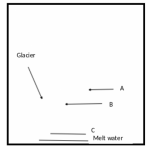KNEC KCSE Geography Paper 1 Question Paper / 2015 KCSE Kericho West Joint Examination
2015 KCSE Kericho West Joint Examination
Geography Paper 1
SECTION A: (25 Marks)
a) Mention two theories advanced to explain the origin of the earth. (2 marks)
b) State three reasons why the interior of the earth is every hot. (3 marks)
5 marks
a) State three conditions for the formation of an artesian basin. (3 marks)
b) Name two ways in which underground water reaches the surface. (2 marks)
5 marks
a) Name two planets without satellites in the solar system. (2 marks)
b) State three effects of the earth’s movement around the sun. (3 marks)
5 marks
a) Name two main types of earth movements. (2 marks)
b) Differentiate between revolution and rotation. (2 marks)
4 marks
a) State three effects of revolution of the earth. (3 marks)
b) The following figure shows a fold.
Name the parts marked A, B and C (3 marks)
6 marks
SECTION B (75 Marks)
Answer question 6 and any other two questions from this section.
a) Study the map extract of Migwani sheet 151/1 provided and use it to answer the following questions.
i) Identify two relief features found in grid square 9865. (2 marks)
ii) Measure the distance of dry weather road from grid reference 074980 to 130986 giving your answer in km. (2 marks)
iii) Give the six figure grid reference for the Kauma dam. (2 marks)
b) i) Calculate the bearing and direction of the school at grid square 0965 from the watertank at grid square 1169. (2 marks)
ii) Citing evidence from the map give three social activities carried out in the area covered. (6 marks)
c) Enlarge the area from gird square 100800 and 130800 to 100840 and 130840 by two and on it mark :
i) Air photo principal point
ii) Road
iii) River Ngoo (5 marks)
d) Describe the drainage of the area covered by the map. (6 marks)
25 marks
a) i) What is a rock ? (2 marks)
ii) Explain the process of formation of mechanically formed sedimentary rocks. (5 marks)
iii) Give three types of mechanically formed sedimentary rocks. (3 marks)
b) Explain three ways in which rocks are significant to economy of Kenya. (6 marks)
c) Students from your school carried out a field study on the type of rocks.
i) One of the rock samples they collected in coral. Give three uses of this type of rock. (3 marks)
ii) Give three methods of data collection they may have used during their study. (3 marks)
iii) State three problems they are likely to have encountered during the field study. (3 marks)
25 marks
a) i) Define a desert. (2 marks)
ii) Identify four features resulting from water action in desert areas. (2 marks)
b) Explain three factors that influence wind deposition in desert areas. (6 marks)
c) With the aid of well labelled diagrams describe the formation of :
i) Barchans (6 marks)
ii) Zeugens (5 marks)
d) State four negative effects of deserts on human activities. (4 marks)
25 marks
a) i) What is a lake ? (2 marks)
ii) Name three ways through which lakes are formed. (3 marks)
iii) List three sources of lake water. (3 marks)
b) By use of a diagram describe how lake Victoria was formed. (5 marks)
c) Briefly explain two reason why some lakes in the Rift Valley have fresh water. (4 marks)
d) State three economic significance of lakes. (3 marks)
e) Students from your school intends to carry out a field study on lakes.
i) State one objective for their study. (1 mark)
i) Identify two methods they will use to record data collected. (2 marks)
iii) Which human activity might they have found to be affecting the lakes. (2 marks)
25 marks
a) i) What is the definition of ground water. (2 marks)
ii) Name two of the sources of ground water. (2 marks)
b) The diagram below shows the underground features in karst landscape.Use it to answer question (i)
i) Name the features marked A, B and C (3 marks)
ii) Describe how feature B is formed. (3 marks)
c)Explain four ways in which ground water is of significance to human activities. (8 marks)
d)Students went for a field study in a limestone area.
i) What problems are they likely to face while in the field. (3 marks)
ii) State two of the surface features they identified. (2 marks)
iii) The two features you have stated in d(ii) above explain how they were identified. (2 marks)
25 marks





